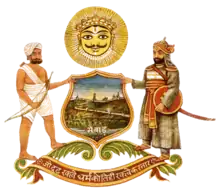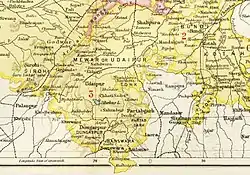Udaipur State
The Udaipur State, also known as Mewar State,[6] was an independent state in northwestern India prior to the formation of the Indian Republic.
Mewar State or Udaipur State | |
|---|---|
| c. 734–1949 | |
 Coat of arms of Udaipur State
| |
Motto: "The Almighty protects the one who upholds righteousness" | |
 Boundaries of Udaipur State in 1909 | |
| Capital | |
| Common languages | Mewari[3] |
| Religion | |
| Government |
|
| History | |
• Established | c. 734 |
| 1949 | |
| Area | |
| 1901 | 33,030[4] km2 (12,750 sq mi) |
| 1941 | 33,517[5] km2 (12,941 sq mi) |
| Population | |
• 1941 | 1,926,698[5] |
Geography
The geographical boundaries of Mewar have waxed and waned over the centuries,[7] but as of 1941, the area of the state was 34,110 square kilometres (approximately the size of present-day Netherlands).[8][9] From the treaty with the British in 1818 to its accession to the Republic of India in 1949, the boundaries of Udaipur state were as follows: the state was bounded on the north by the British district of Ajmer-Merwara; on the west by Jodhpur and Sirohi; on the southwest by Idar; on the south by Dungarpur, Banswara and Pratabgarh; on the east by Bundi and Kotah; and on the northeast by Jaipur.[10]
History
State formation and emergence as regional power
Mewar was founded by Bappa Rawal, formerly a chieftain of the Mori king of Chittor, who acquired control of Chittor in c.728.[11] Nagda was the first capital of Mewar and continued to be so until c. 948 when the ruler Allat moved the capital from Nagda, Rajasthan to Ahar.[1]
Mewar and the Mughals
In 1615, after four decades of skirmishing, Mewar and the Mughals entered into a treaty under which Mewar territory under the Mughals' possession was returned in exchange for the crown prince of Mewar attending the Mughal court and Mewar providing a force of 1,000 horsemen to the Mughals.[12]
Maratha influence
The Marathas made the first successful incursion into Mewar territory in 1725 and, subsequently, continued to exert increasing influence not only on Mewar but also surrounding states of Dungarpur, Banswara, and Bundi.[13] To counter the Marathas, Maharana Jagat Singh of Mewar convened a conference of Rajput rulers in Hurda in 1734, but no agreement materialised.[13] Maratha power continued to grow, with the Marathas regularly extracting hefty tributes from Mewar over the remaining part of the century.[13]
Mewar in the British Raj
By 1818, the armies of Holkar, Scindia, and Tonk had plundered Mewar, pauperising its ruler and people. [14]As early as 1805, Maharana Bhim Singh of Mewar approached the British for assistance but the Treaty of 1803 with Scindia prevented the British from entertaining the request. [14] But by 1817, the British too were anxious to have alliances with Rajput rulers and the Treaty of Friendship, Alliances and Unity was concluded between Mewar and East India Company (on behalf of Britain) on 13 January 1818.[14][15]
Under the treaty, the British Government agreed to protect the territory of Mewar, in return for which Mewar acknowledged British supremacy and agreed to abstain from political associations with other states and to pay one-fourth of its revenues as tribute for 5 years, and three-eight in perpetuity.[15] A constitution for Udaipur State was adopted on May 23, 1947.[16] The last ruler of Udaipur State signed the accession to Independent India on 7 April 1949.[17]
Maharanas
Until 1303, the rulers of Mewar were called 'Maharawals'.[1] Upon the death of Rawal Ratan Singh during the sack of Chittorgarh by Allauddin Khilji 1303, Hammir Singh became the ruler of Mewar and styled himself as 'Maharana', which is what its rulers were called until dissolution of the state in 1949.[1]
| Sisodia Dynasty at Chittor | ||||||||||||||||||||||||||||||||||||||||||||||||||||
| ||||||||||||||||||||||||||||||||||||||||||||||||||||
| Sisodia Rajput Dynasty at Udaipur | ||||||||||||||||||||||||||||||||||||||||||||||||||||||||||||||||||||||||||||||||||||||||||||||||||||
| ||||||||||||||||||||||||||||||||||||||||||||||||||||||||||||||||||||||||||||||||||||||||||||||||||||
British Residents and Political Agents
Political Agents employed by the East India Company to oversee their affairs in the state included James Tod, who held the office from March 1818 to June 1822. The post of British Resident that superseded this position was twice held by Alan Holme (1908 – 1911 and 1916 – 1919).
Administrative structure
At the time of the 1901 census, the state was divided into 17 administrative sub-divisions - 11 zilas and 6 parganas, the difference between a zila and pargana being that the latter was larger and broken up into further subdivisions.[19] Further, there were 28 principal jagirs and 2 bhumats.[20] Each zila was administered by a hakim, a state official, supported at each tehsil (a zila sub-division) by an assistant hakim.[21] The state was poorly managed before British rule. The revenue of Udaipur state was Rs.4,00,000 with a debt of Rs.29,00,000 in 1819, after which the British took over the administration. The state revenue showed improvement under British agents, the revenue rising to Rs.8,00,000 in 1821 and an average of Rs.28,00,000 in 1899–1900.[22]
Land tenure
The principal forms of land tenure in the state were jagir, bhum, sasan, and khalsa. Jagirs were grants of land made in recognition service of a civil or political nature. Jagirdars, the holders of jagir, usually paid a fixed annual tribute called chhatund on an annual basis, and nazarana on the succession of a new Maharana. On the death of a jagirdar, the jagir reverted to the Maharana until the late jagirdar's successor was recognized by the Maharana. Those holding bhum tenures paid a small tribute or nominal quit-rent (bhum barar), and were liable to be called on for local service. Sasan (also known as muafi) holders were not liable for payments to the Maharana but taxes were sometimes recovered from them. Khalsa (crown lands) holders were cultivators who were undisturbed in their possession as long as they continued to pay land revenue.[23] As of 1912, 38% of the land revenue of the State was from khalsa land, the rest from other forms of tenure.[24]
See also
References
- Bhattacharya, A.N. (2000). Human Geography of Mewar. Himanshu Publications. ISBN 9788186231906.
- Agarwal, B.D. (1979). Rajasthan District Gazetteers, Udaipur. Jaipur: Directorate of District Gazetteers.
- Ojha, Gaurishankar Hirachand (1990). उदयपुर राज्य का इतिहास [History of Udaipur State]. Rajasthani Granthagar.
- Bannerman, A.D. (1902). Census of India 1901, Vol. XXV-A, Rajputana, Part II Imperial Tables (PDF). Newal Kishore Press.
- Dashora, Yamunalal. Mewar in 1941 or A Summary of Census Statistics. R.C. Sharma.
- Agarwal, B.D. (1979). Rajasthan District Gazetteers: Udaipur. Jaipur: Government of Rajasthan. p. 230.
- Gupta, R.K.; Bakshi, S.R., eds. (2008). Studies in Indian History: Rajasthan Through the Ages Vol. 5. New Delhi: Sarup & Sons. pp. 64. ISBN 978-81-7625-841-8.
- "The World Factbook: Netherlands". Central Intelligence Agency. Retrieved 22 December 2017.
- Dashora, Yamunalal (1942). Census of Mewar, 1941. Alwar: Sharma Bros.
- Based on map of Mewar shown with the article.
- Vaidya, C.V. (1924). History Of Mediaeval Hindu India. II. Poona: The Oriental Book Supplying Agency. pp. 75.
- Panagariya, B.L.; Pahariya, N.C. (1947). Political, socio-economic and cultural history of Rajasthan (Earliest times to 1947). Jaipur: Panchsheel Prakashan. Retrieved 2 May 2019.
- Mathur, Tej Kumar (1987). Feudal polity in Mewar. Jaipur and Indore: Publication Scheme.
- Gupta, R.K.; Bakshi, S.R., eds. (2008). Studies in Indian History: Rajasthan Through the Ages Vol. 5. New Delhi: Sarup and Sons. pp. 64. ISBN 978-81-7625-841-8.
- Aitchison, C.U. (1909). A Collection of Treaties, Engagements and Sanads Relating to India and Neighbouring Countries Vol. III. Calcutta: Superintendent Government Printing, India. pp. 10–32.
- Darda, D.S. From Feudalism to Democracy. New Delhi: S. Chand & Co. (Pvt.) Ltd.
- Princely States of India
- The Rajputs of Rajputana: a glimpse of medieval Rajasthan by M. S. Naravane ISBN 81-7648-118-1
- Agarwal, B.D. (1979). Rajasthan District Gazetteers: Udaipur. Jaipur: Government of Rajasthan. p. 2.
- Imperial Gazetteer of India : Provincial Series Rajputana. Calcutta: Superintendent of Government Printing. 1908. pp. 106–168.
- Ojha, Gaurishankar Hirachand (1999). उदयपुर राज्य का इतिहास. Jodhpur: Rajasthani Granthagar. pp. 15–16.
- A Gazetteer Of The Udaipur State With A Chapter On The Bhils And Some Statistical Tables by Erskine, K. D. ..Chapter XII, Finance.
- Erskine, K.D. (1908). Rajputana Gazeteers, Vol II-A (The Mewar Residency). Ajmer: Scottish Mission Industries Co. Ltd. pp. 71–72.
- Administration Report of the Mewar State for the Year 1910-11. Ajmer: Scottish Mission Industries Co., Ltd. 1911. pp. 1.